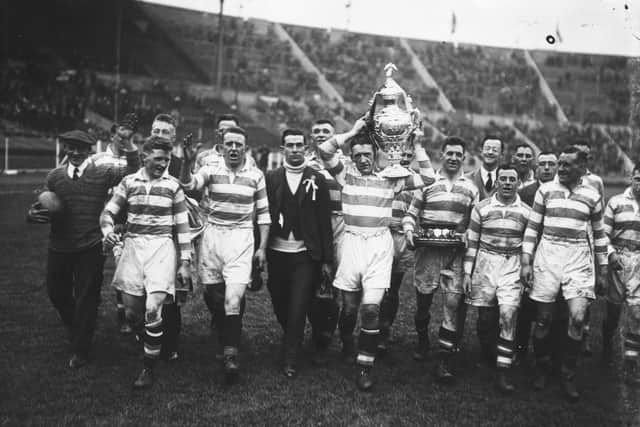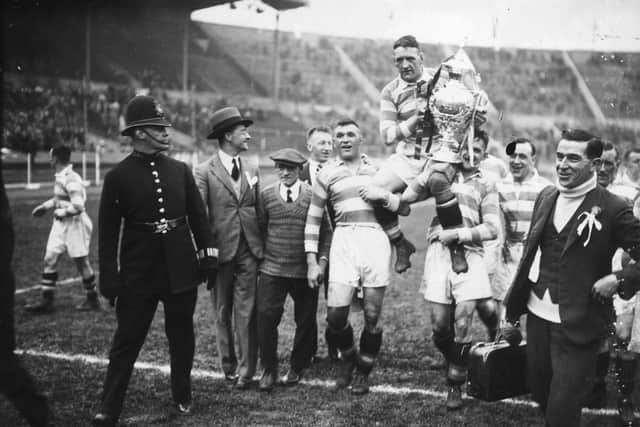150 years: A history and heritage of Halifax RLFC
and live on Freeview channel 276
A group of young lads from the Halifax Rifle Volunteers, based at the Drill Hall on Prescott Street, must have seen reports of football matches, relatively new to West Yorkshire.
They placed an advert in the local press for anyone else interested to join them in a meeting at the Upper George, and a club was formed. The aim: simply to play matches between themselves on fields around the town centre.
Advertisement
Hide AdAdvertisement
Hide Ad"Football” in West Yorkshire in the 19th century meant rugby, so this was the game they took up, helped by an older guy who had played for Huddersfield.


A year later they were ready to compete against another team and challenged Leeds Athletic Club to a match on their ground at Woodhouse Moor in Leeds, on November 21, 1874.
A month later, the first home match followed, against Wakefield Trinity on a cricket field in King Cross Street. Both matches were drawn.
Fixtures were later played at Ovenden, Savile Park and Hanson Lane, before Thrum Hall was acquired in 1886.
Advertisement
Hide AdAdvertisement
Hide AdHalifax quickly became quite successful. The governing body, the Rugby Football Union, frowned on competitive football, but in 1877 a Yorkshire Cup competition was somehow allowed through, and Halifax became the first ever winners, beating York in the final in Leeds. They went on to win the competition five times in total.


But by 1895, northern clubs were becoming seriously dissatisfied with the way the game was being run by well-to-do gentlemen from the south.
Halifax joined 21 other leading clubs in breaking away to form what was first called The Northern Union, and later rugby league.
Initially very little changed; the same players largely played for the same teams under the same rules. Over the years those rules were altered in attempts to make the game more appealing to spectators, and players could now be paid, at first just compensation for missing time at work.
Advertisement
Hide AdAdvertisement
Hide AdHalifax finished runners-up in the first season under new governance. Then, in the 1902-03 season, they achieved a remarkable double when they finished top of the league table and won the Challenge Cup, retaining the latter trophy the following year.
The Challenge Cup final was moved to Wembley Stadium in 1929, with Halifax becoming one of the first to sample its magic when they beat York there in 1931.
They were back in 1939, when Salford were vanquished. Under war-time conditions Halifax reached the next two cup finals, both played at Odsal in 1941 and 1942, but lost both times to Leeds.
Another great side emerged in the 1950s, reaching a number of Championship and Challenge Cup finals, though generally finishing runners-up. This included the 1954 Challenge Cup final replay at Odsal, played in front of a record crowd of more than 102,000.
Advertisement
Hide AdAdvertisement
Hide AdThe Championship was won again in 1965, with another great period following in the 1980s, when the league was topped in 1985-86 and the Challenge Cup added at Wembley in 1987.
The advent of Super League in 1995 saw Halifax included, but the loss of the ground at Thrum Hall soon afterwards was a blow.
After the move to The Shay, the 1998 season brought a highest Super League finish of third, though financial issues resulted in relegation in 2003.
Other lows infamously included the 1977-78 season, which witnessed 24 consecutive defeats, including one against amateur side Cawoods, and only two victories in total, resulting in a bottom of the pyramid finish.
Advertisement
Hide AdAdvertisement
Hide AdSince 2003 the club has been unable to get back to the top flight, despite often figuring near the top of the Championship.
In 2010 they beat Featherstone Rovers to win the Championship Grand Final, but it was at a time when promotion was not on the table.
Could promotion back to Super League be back on the table in their 150th year…?